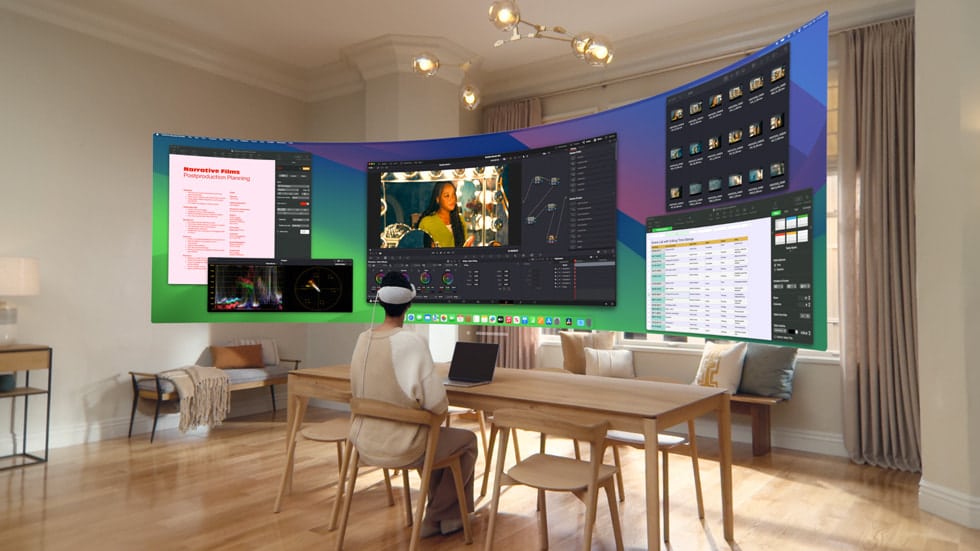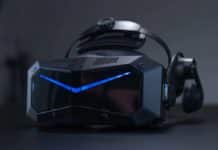Last Update on December 27, 2025
Launched in February 2024 in the United States and then gradually rolled out internationally, the Apple Vision Pro is now celebrating its first year and a half. By late 2025, it’s time to provide an objective assessment: has the **spatial computing** revolution promised by Apple lived up to its promises? Between major software evolutions, the development of the app ecosystem, and positioning against increasingly aggressive competition, here is a complete analysis to understand where Apple’s premium mixed reality headset really stands.
Apple Vision Pro in 2025: Is the promise of spatial computing kept?
When Tim Cook introduced the Vision Pro, he described it as “the beginning of a new era for computing.” Eighteen months later, it must be noted that this statement deserves some nuance. The headset has undeniably made an impression with its technological prowess, but its adoption remains confidential, even among the most convinced early adopters.
Technology that is still impressive in 2025
On the hardware side, the Vision Pro hasn’t aged a bit. The micro-OLED screens totaling over 23 million pixels still offer the best resolution on the market. The 12-millisecond latency provided by the R1 chip remains an unmatched benchmark. Eye and gesture tracking work with surgical precision that puts the competition to shame.
However, the limitations identified at launch persist. The weight of 600 grams continues to limit prolonged sessions. The two-hour battery life with the external battery has not evolved. And the field of view, while decent, remains below what some more recent competitors offer.
Daily use: between fascination and frustration
User feedback after 18 months of use reveals an interesting trend. The majority of owners use their Vision Pro occasionally rather than daily. The most popular use cases remain:
- Watching immersive content: 3D movies, Apple spatial videos, immersive experiences
- The virtual desktop: connecting with a Mac for a giant virtual screen
- FaceTime calls in Persona: despite initial criticism of the rendering
- Meditation and relaxation: highly appreciated zen immersive environments
On the other hand, the dream of a complete computer replacement remains distant. The promised spatial productivity still requires major improvements to rival a traditional screen + keyboard setup.
Ecosystem Evolution: VisionOS 2 and current Killer Apps

While the hardware hasn’t changed, the most notable progress has been on the software side. VisionOS 2, deployed in September 2024 and enriched throughout 2025, has significantly improved the user experience.
Major new features of VisionOS 2 in 2025
Apple listened to community feedback to refine its spatial operating system. Among the most significant improvements:
- Spatial photos from any image: AI now converts 2D photos into immersive memories
- Improved Travel Mode: usable in cars and planes with optimized stabilization
- Custom gestures: ability to create your own gesture shortcuts
- Spatial SharePlay: watching content together in virtual reality
- Ultra-wide Mac Virtual Display: equivalent to a 65-inch curved screen
Integration with the Apple ecosystem has also strengthened. Switching from one device to another now works seamlessly, and continuity with the iPhone 16 and M4 Macs reaches a remarkable level of fluidity.
Killer Apps that justify the purchase in 2025

The visionOS App Store now features over 2,500 native applications, up from just 600 at launch. Some stand out particularly:
For productivity:
- Microsoft 365 Spatial: office suite completely redesigned for space
- Zoom for Vision Pro: immersive video conferencing with realistic avatars
- JigSpace: 3D visualization for professionals
For entertainment:
- Disney+ Immersive: exclusive Marvel and Star Wars content in mixed reality
- Apple TV+ Spatial: movies and series in a virtual environment
- NBA League Pass: basketball games in immersive vision
For creation:
- DaVinci Resolve: video editing on a giant virtual screen
- Adobe Creative Suite: finally available with spatial optimization
- Procreate Dreams: intuitive 3D animation
2025 Comparison: Vision Pro vs Competition (Meta, Samsung)
The mixed reality landscape has evolved considerably since the launch of the Vision Pro. Apple is no longer alone in the premium segment, and the comparison with alternatives deserves an in-depth analysis.
Apple Vision Pro vs Meta Quest 3S and Quest 4
Meta has consolidated its position with the Quest 3S at €299 and is preparing for the launch of the Quest 4 scheduled for early 2026. For a detailed comparison with the current model, see our article Meta Quest 3 vs Apple Vision Pro.
| Feature | Vision Pro | Meta Quest 3 | Quest 3S |
|---|---|---|---|
| Price | €3,999 | €549 | €329 |
| Resolution per eye | 3660 × 3200 | 2064 × 2208 | 1832 × 1920 |
| Processor | M2 + R1 | Snapdragon XR2 Gen 2 | Snapdragon XR2 Gen 2 |
| Eye tracking | Yes (native) | No | No |
| Battery life | 2h (external) | 2h (integrated) | 2.2h (integrated) |
| Weight | 600g | 515g | 514g |
The value for money clearly leans in favor of Meta for the general public. However, for professionals and demanding users, the image quality and ecosystem integration of the Vision Pro remain unmatched.
Samsung XR and new entrants
Samsung, in partnership with Google and Qualcomm, unveiled its XR headset scheduled for 2025. The announced features promise direct competition with Apple: micro-OLED screens, advanced eye tracking, and Android XR integration. A serious threat to Apple’s supremacy in the premium segment.
Long-term impact on the AR/VR industry and the Metaverse
Beyond sales (estimated between 500,000 and 800,000 units by late 2025), the Apple Vision Pro has deeply influenced the entire industry. According to Wikipedia, mixed reality combines real and virtual environments, and the Vision Pro has set new standards in this field.
Standards raised by Apple
Several innovations introduced by Apple are now considered prerequisites by consumers:
- Micro-OLED display quality: no more grainy LCD screens
- Native eye tracking: for intuitive navigation without controllers
- High-definition color passthrough: credible mixed reality
- Integrated spatial audio: 3D sound without additional headphones
Competitors have had to upgrade their roadmaps. Meta is working on higher-resolution screens, Google is investing heavily in eye tracking, and even players like Sony or HTC are accelerating their R&D.
The reconfigured metaverse
Ironically, Apple has never used the term “metaverse” to describe its vision. Yet, the Vision Pro has helped redefine this concept. Rather than a persistent virtual world like Meta’s, Apple offers an augmentation of the real world. This pragmatic approach appeals more to users skeptical of the promises of Zuckerberg’s version of the metaverse.
Should you invest in an Apple Vision Pro in late 2025 or wait for v2?
This is THE question potential buyers are asking. With persistent rumors of a Vision Pro 2 and a more affordable model, the timing of the purchase becomes strategic.
Arguments for buying now
- Mature ecosystem: VisionOS 2 and over 2,500 native apps
- Falling prices: appearance of Apple-certified refurbished models starting at €2,999
- Resale value: early models still resell well
- Concrete uses: if you have an identified professional need
Reasons to wait
- Vision Pro 2 expected: likely in 2026 with M4 chip and lighter design
- Rumored “SE” model: more accessible version without the premium design
- Samsung competition: could offer better value for money
- Rapid market evolution: standards change quickly in XR
Our verdict for late 2025
If you are a developer, content creator, 3D professional, or technology enthusiast with a comfortable budget, the Vision Pro remains a relevant investment. The experience it offers remains unique on the market.
For the general public or the curious, we recommend either waiting for Apple’s 2026 announcements or turning to the best VR headset in 2025 suited to your budget and needs.
Durability and support: what is the Vision Pro worth in the long term?
An often-overlooked aspect in analyses: durability. After 18 months, initial feedback on hardware aging is encouraging.
Build quality
Premium materials (aluminum, laminated glass) stand up well to daily wear and tear. The fabric cushions are replaceable, and Apple offers spare parts. The Light Seal (facial interface) may wear out but is easily replaced.
Point of caution: the external battery, used intensively, may lose capacity after several hundred cycles. Replacement cost: approximately €199.
Guaranteed software support
Apple is committed to at least 5 years of support for major visionOS updates. 2024 buyers are therefore covered until at least 2029, ensuring the longevity of their investment.
FAQ: Frequently asked questions about Apple Vision Pro in 2025
Is the Apple Vision Pro worth it in 2025?
For professionals and creators, yes. The Vision Pro offers unmatched image quality and Apple ecosystem integration. For the general public, the utility/price ratio remains difficult to justify compared to much cheaper Meta alternatives.
What are the new features of VisionOS 2?
VisionOS 2 brings 2D photo conversion into spatial images, an improved travel mode, spatial SharePlay, customizable gestures, and an ultra-wide Mac Virtual Display equivalent to a 65-inch screen.
What is the difference between the Vision Pro and the Meta Quest 4?
The Vision Pro remains superior in display quality (23M pixels vs ~8M estimated), native eye tracking, and Apple integration. The Quest 4 (expected 2026) promises a price 5 to 6 times lower and a more extensive game library.
Can you use the Vision Pro with prescription glasses?
Not directly. Apple offers custom Zeiss optical inserts (€149 to €199 depending on correction) that attach magnetically inside the headset for glasses wearers.
Will the Apple Vision Pro 2 be released in 2025?
No. According to analysts, the Vision Pro 2 is expected in 2026, with an M4 chip, a lighter design, and possibly a lower price. A more accessible “SE” model could also be introduced.
Conclusion: A mixed but promising assessment
Eighteen months after its launch, the Apple Vision Pro perfectly embodies Apple’s DNA: an ambitious vision, flawless technical execution, but an assumed elitist positioning. Sales remain confidential, general public adoption non-existent, and yet, the Vision Pro has undeniably moved the needle in the AR/VR industry.
By late 2025, buying a Vision Pro is more of an investment in the future than a current necessity. Those who take the plunge discover a unique, sometimes magical, often under-exploited experience. While waiting for a more accessible version or a second generation, the Vision Pro remains a demonstration of technological strength that foreshadows the computing of tomorrow.
👉 To further your thinking, discover our complete guide on the best VR headsets in 2025 and our detailed comparison Meta Quest 3 vs Apple Vision Pro.











